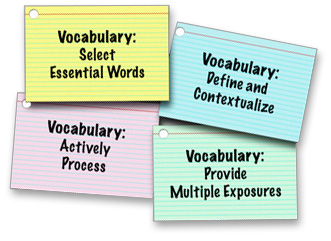What should content-area teachers know about vocabulary instruction?
Page 2: Components of Effective Vocabulary Instruction

When you consider the number of words that students must understand if they are to successfully make sense of a given text, you soon realize that teaching the meaning of those words one by one is insufficient.
Listen as Sharon Vaughn identifies some of the things students need to be able to do to learn new word meanings (time:1:54).

Sharon Vaughn, PhD
Professor of Special Education
Director of the Vaughn Gross Center for Reading and Language Arts
University of Texas, Austin
Transcript: Sharon Vaughn, PhD
There are three things that students need to be able to do in order to accumulate the number of word meanings they need. Number one, they need to be taught the meanings of important, necessary, complex words such as egalitarian, or manufacture, or cell in the sense of biology. Number two, they need to learn how to use text as a source for deriving the meaning of words that they don’t know. So as part of number two, they first need to be able to recognize I don’t know what that word means, and that’s no small problem. Students can’t just plow through text and not recognize when there’s a word that they don’t know. They need to know the word they don’t know, and then they need to be able to use the text by rereading previous text and rereading other text to find out oh, that’s what that word means, and particularly in the content area many of the complex words are defined in the text itself. Number three, students need to be able to be word-finders and word-collectors outside the content area so that when they’re listening to television, when they’re eavesdropping on conversations, or when they’re reading other text, they attend to words they don’t know, they remember the word they don’t know, and they collect the meaning of those words so that they become independent word-meaning learners, and it is with the combination of those three things that they’re likely to be very successful.
Teachers can provide more-effective vocabulary instruction by:

- Selecting essential words
- Explicitly defining and contextualizing those words
- Helping students to actively process the information
- Providing multiple exposures to the words
These four elements will be explained in greater detail on the module pages that follow.